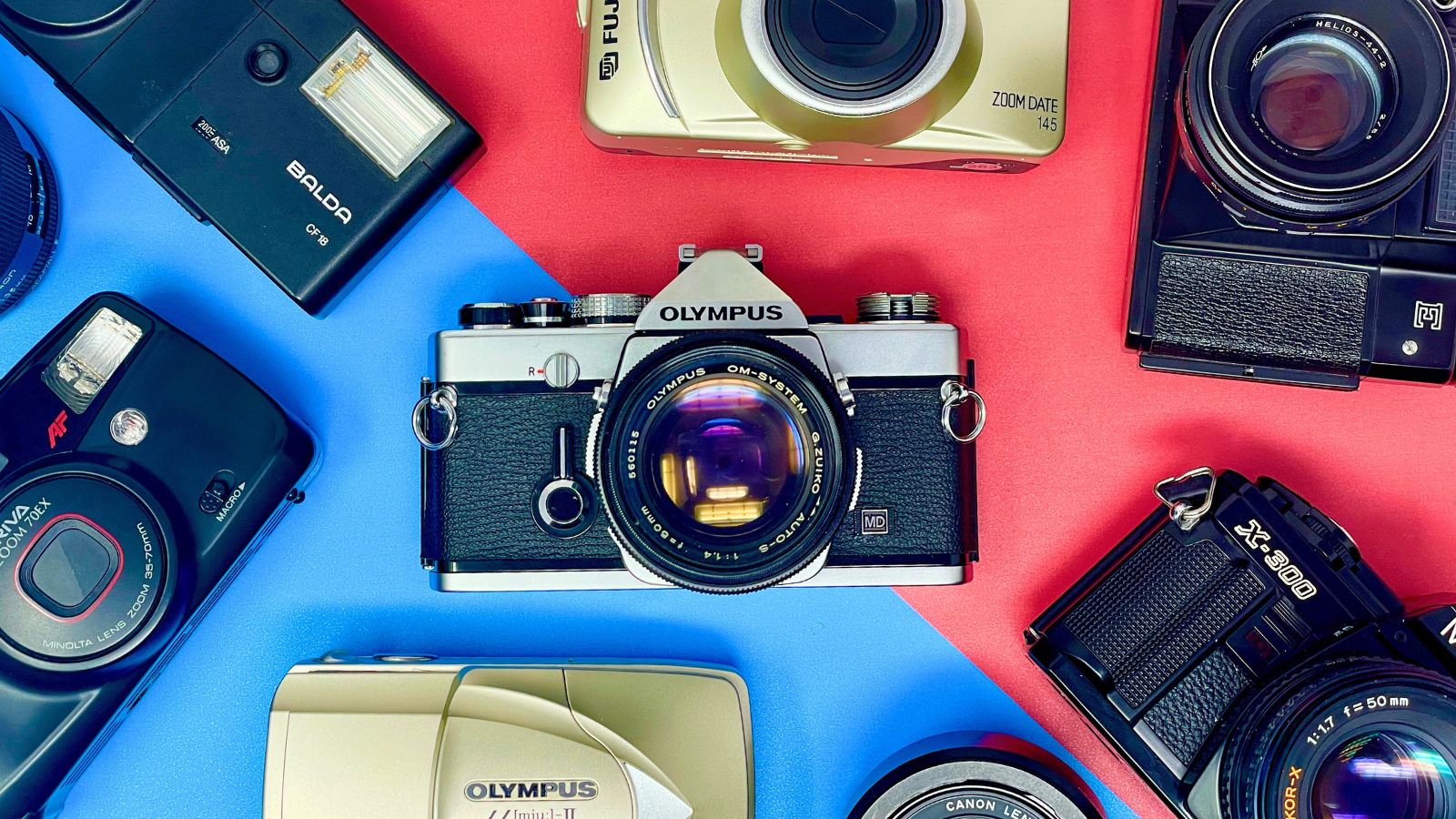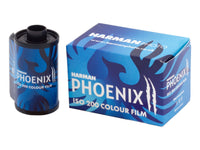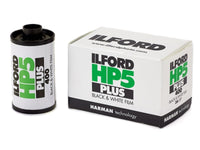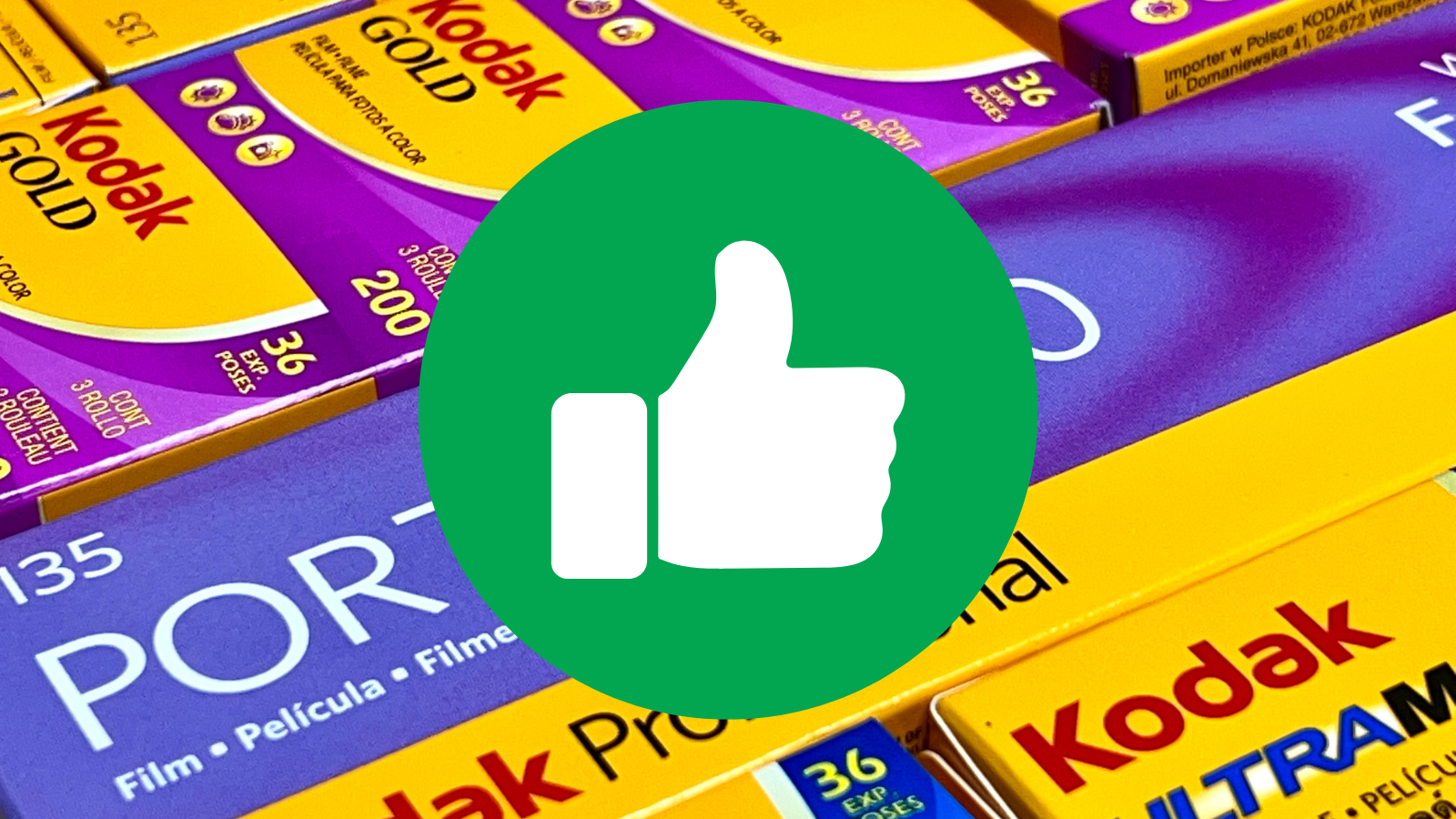Recent posts
Shop the article

The Top Secret Site Visit: When Paul Met Phoenix II
By Paul McKay
Visiting a film factory is always a thrilling affair. There’s something wonderfully Charlie-in-the-chocolate-factory about the experience: wandering around big buildings housing big machines. Seeing film canisters being produced, packed, and stacked in piles: ready for photographers around the world to capture special moments within their tiny rolls.
The adventure is extra thrilling when you’re shooting the visit on a brand new emulsion, and this is the situation in which we found ourselves a few months ago! I had been invited up to Mobberley - the home of Harman Tech and the historic production site for Iford and Kentmere films - and these types of invitations are often the sign of an exciting announcement 🤫 Sure enough I was greeted with the first look at a brand new colour film - researched, made and finished on-site - which has since been launched to market as Phoenix II. So let's look back at that visit and lift the curtain on what it's like to visit a film factory...
Reminder: who are HARMAN?
A very quick history recap: HARMAN Technology is the company behind the manufacture, marketing and distribution of all black-and-white Ilford and Kentmere films and paper. They took ownership of this section of the business as part of a management buyout in 2005, as the global digital revolution threatened the future of the brand.

I hear you like HP5... Shot in the packaging section of the factory!
They do not have exclusive ownership of the Ilford brand - which is why you’ll sometimes see Ilford colour film products or disposable cameras made elsewhere - but they are the custodians of the people, equipment, and science that has brought so many photographers joy over the past century. You can read more about the history of the historic brand on our Ilford page.
Setting the scene: the Harman film factory
The HARMAN film factory is in Mobberley Cheshire, on land that has hosted photosensitive production facilities since 1901! Over the past 125 years the site has seen continual upgrades, expansions, and changes in ownership (from Brooks-Watson Daylight Camera Company Ltd, to Rajar Ltd, to Ilford Ltd, and now to HARMAN Technology).

A lovely day in Mobberley - photo taken right in the middle of the site, with part of the factory in the background
Some parts of the site were sold for private development in the late 2000s as Harman wrestled with making film photography profitable once more, but there is still plenty of room for producing tens of thousands of rolls of film each week!
In fact Harman have recently announced new investment into their production facilities - looking to modernise and increase capacity - ready for the continued growth in analogue interest around the world, and this was my first chance to see it in action.
What happens on a visit to a film factory?
As with any industrial site, there are health and safety rules to be followed. In fact there are lots of posters around the site that reflect different safety concerns from the past century, some with a surprising frankness!

I feel this...
So the first thing you do when visiting the film factory is put on a high-vis jacket - very fetching. You also need to be accompanied by members of the factory team as you go around the equipment. This isn’t just a safety concern, it also means that you don’t get lost wandering around the huge area.
There are office buildings on-site, which is where I met the management team of Harman to be shown the new film (Phoenix II!) and discuss the material improvements and marketing plans. After a few hours poring over sample photos, grain comparisons and branding designs it was time for lunch - and for me, the first opportunity to load Phoenix II into a real camera.
I chose to use my Pentax 17 half-frame 35mm camera to test the first roll of Phoenix II. This is because I knew that I could trust its autoexposure, its flash compensation, and the quality of its lens - all the variables that would make a difference to the final images. I know exactly what the Pentax 17 can do with Kodak’s colour film, so it would allow for a fair comparison when I saw the results for Phoenix II.

It was also because Harman had made a good deal (quite rightly!) about the much smaller grain that they’ve been able to produce in Phoenix II vs Phoenix I. What better way to test grain size than by shooting half-frame, which would automatically magnify any issues in the emulsion?
With my camera loaded it was time for the factory tour. We would be taken around all the key areas that go into film manufacture, and also get first sight of the brand new machinery that Harman is installing. Exciting times!
Making colour film: how hard can it be?
I’m going to keep my description of making film very simple, so we don’t get distracted by 100+ years of scientific research and development.
Step one: cook the emulsion (see - I said I’d keep this simple!)
The emulsion is the light sensitive material that gets coated onto the plastic film backing - along with other layers which each have their own role in ensuring a high quality final image. Within the emulsion are silver halide crystals and the exact chemical make-up is critical to the results on film. Variations in the recipe and crystal size/density can affect ISO, contrast, grain shape, and sensitivity to different wavelengths of light. This is the moment that differentiates Delta 3200 from Delta 100; Ilford HP5 from FP4 - and the exact ingredients, timings and temperature that go into each product are more closely guarded than KFC’s fabled 11 spice mix!
Consistency is also key: there can’t be a change in recipe across a length of film - or between rolls of the same product - so the emulsion must be mixed and monitored to an incredibly high precision. This all happens in rooms that remind me of a brewery - big pipes carrying hot and cold water, large vats whirring in the dark, temperature dials on EVERYTHING!
 The new film - posing with one of the machines responsible for the emulsion
The new film - posing with one of the machines responsible for the emulsion
This is also where Harman have had to upskill quickly to produce Phoenix film: colour film typically requires three layers of emulsion instead of one - which drastically changes the production flow. When you stand in one of these rooms, surrounded by machines that date from the 60s, the achievement is striking.
Step two: coat the film
When the emulsion has been baked to the correct recipe it is cooled down and sent into storage, ready for its turn in the coating machine. This allows Harman to prioritise different films depending on global demand and marketing plans - ramping Delta 3200 up in the winter months, making sure they’ve made enough Kentmere 200 for launch, that kind of thing
And the coating machine is MASSIVE! It has a building all to itself, a control centre that could launch a spaceship, and an intricate system of warning lights.
Incidentally this is where a single mobile phone screen flashing up with a notification could cost thousands and thousands of pounds of lost product, so during the site tour you aren’t typically allowed near the place where the coating actually happens - that must be kept in pitch black at all times.
But the science is fascinating: different chemical layers are melted and gently floated down a slope as a huge roll of sheet plastic glides past and collects them in order - forming a microscopic film (guess where the name comes from…) of emulsion, stabiliser, antihalation, and everything else required to produce a modern photosensitive product.

Some of the (many) water pipes in the factory - shot with Harman Phoenix ii 35mm film and flash
Except with Phoenix II there are THREE emulsion layers - not just one - which I assume is part of the reason that Harman haven’t yet worked out how to incorporate anti-halation into their colour products. Personally I’m not too upset by this - I love the glow that Phoenix produces in bright light - but I’m sure that it’s something that will get tweaked in future iterations.
When the huge plastic sheet has been completely coated it is rolled up - now called a ‘master roll’ - and cut into smaller rolls, depending on the format of film that’s required. 35mm rolls are 35mm wide (shock) and 120 rolls are 61mm wide.
Film sharks: we’re going to need a bigger box
My favourite part of the entire factory is the final part of the tour. This is for anyone who’s ever got excited about robots - a chance to watch specialist machines turn the cut-down master rolls of film into final product. Boxed, packaged, and ready to ship out to retailers and photographers around the world.
Particularly ingenious is the way that canisters are transported across stations. Conveyor belts of hidden magnets pull their metallic bodies in all directions. Often all you can see from the walkway is a line of film strips, pointing upwards like shark fins out of the water, whizzing towards the next part of the process.
Small robots are responsible for attaching canister tops and printing miniature barcodes; large robots unfold cardboard boxes and load hundreds of finished rolls of film into parcels ready for shipping to Analogue Wonderland 😅
The factory site - shot on Phoenix II 35mm film
Harman had promised me that Phoenix II would show smaller grain, wider exposure latitude, and more natural colours versus the original Phoenix I emulsion.
And sure enough, that’s exactly what I found - even when shooting on a half-frame camera that will naturally accentuate the film grain. Have a look:









What's next for Harman colour film
The performance of Phoenix II is astonishing. Not because it’s a technically perfect colour film - it definitely isn’t, retaining a distinct character in the final photos - but because it has been created from scratch over the past few years on-site in Cheshire.
It’s hard to comprehend the scale of the task, but going around the factory gives countless clues that adding colour into a black-and-white product is an incredible feat. For example all the historical quality control systems dotted along the production line are designed for monochrome - to check colour film requires an entirely different set of chemistries and an entirely different calibration for the light meters. I know how much time and effort it takes for our photo lab to add another chemistry to our offering - and that’s without the pressure of an entire factory’s output relying on the result!
Throughout our day together the Harman team were keen to stress that Phoenix II is ‘another step along the journey’. The income they make from selling Phoenix will go straight into the R&D team’s colour film budget, and they continue to include a QR code inside every Phoenix II box where photographers and labs can give direct feedback on results.
I am a big fan of the ambition and the drive for improvement, but I also think that Phoenix II is worth celebrating in its own right. A fantastic colour film with tons of character - and my personal favourite from the whole day was this grungy indoor shot that shows halation and a delightfully dark green tinge… It’s sparked a whole idea about industrial photography that I can’t wait to bring to life!

If you’re keen to see the specific differences between Phoenix II and Phoenix I (and Kodak Gold) then you can find Amy’s direct comparison in our article here.
Otherwise has this sparked an interest in Harman’s colour journey? And would you ever be interested in visiting the factory?!
Ready to dive in?
Keep Reading
View all
Vintage Camera Drops - Summer 2025
We have recently received a treasure trove of vintage film cameras and lenses! Someone who's worked in the industry for the past ten years has kindly sourced and graded for us a wonderful mix of SLRs, point-and-shoots, rangefinders, compacts, and lenses. Released in weekly drops!

The Top Secret Site Visit: When Paul Met Phoenix II
Early in 2025 we were invited to Harman’s film factory to find out how their R&D team had progressed their understanding of colour film PLUS I had the first chance to shoot the emulsion that has now been launched as Phoenix II
Subscribe to our newsletter 💌
Sign up for our newsletter to stay up to date on film photography news, sales and events:
Free Tracked Shipping
On all UK orders over £50
Passion For Film
An unbeatable range and an on-site lab
Our Customers Trust Us
Thousands of independent 5* reviews
All Deliveries are Carbon Neutral
Independently audited and verified by Planet
- Opens in a new window.







1 Comment -
Mark Moulds •
I would love to visit the factory. That was a very interesting blog and very well written